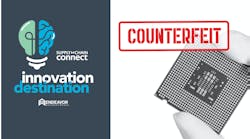Beyond the Label: How Anti-Counterfeit Packaging is Revolutionizing the Industry
The global anti-counterfeit packaging market is expected to register a staggering double-digit CAGR of 11.9% by garnering a market value of US $422.8 Billion. The growth of the market can be attributed to:
- High growth on account of growing adoption of such packaging primarily by the pharmaceutical companies across the globe.
- Increasing consumer awareness pertaining to the harmful effects of spurious goods is expected to drive growth.
- Rising technological innovation for the production of highly secure packaging for use in application industries is expected to drive growth over the forecast period.
The COVID-19 pandemic affected the sales of anti-counterfeit packaging. But, on the other hand, the demand for safe packaging increased by leaps and bounds in the pandemic period. Increasing efforts by major manufacturers across the globe to drive down the losses incurred by the manufacture of counterfeit products is expected to benefit the industry growth. The anti-counterfeit packaging industry is expected to register high growth over the forecast period driven by the demand for product authentication techniques in fast moving consumer goods (FMCG) industry.
The demand for anti-counterfeit packaging products is expected to be driven by the imposition of stringent regulations to eliminate the production of spurious products, in addition to the growing efforts taken by national governments primarily across Europe and North America to counter the threat of spurious products.
Opportunities for Anti-Counterfeit Packaging Market
The packing industry is undergoing drastic change. Smart and interactive packaging are ensuring safety of products. In addition, the expansion of end user sectors that range from food and beverage to pharmaceutical products is creating lucrative opportunities for anti-counterfeit packaging market. The industry witnesses a number of mergers and acquisitions to improve company’s revenues.
The anti-counterfeit packaging industry exhibits the presence of a number of manufacturers that lay high emphasis on research and development for the production of advanced technology products in a bid to gain the market share. The companies in the industry possess a large number of patents in order to differentiate their product and eliminate the threat of product poaching by competitors in the market.
The industry exhibits integration across the value chain, from the production and development of security products and technologies to product distribution. In addition, companies undertake joint ventures and collaborations for the production of advanced technology solutions to increase the revenues.
As per Future Market Insights (FMI), the mass serialization technology segment of anti-counterfeit packaging market is estimated to account for around 29% of the total market share in 2022, with demand growing at a 9.9% CAGR over the forecast period.
East Asia will emerge as a lucrative region, accounting for 37% of the total market share in 2022. The U.S. anti-counterfeit packaging market will expand 4.6% year-over-year. Furthermore, the total valuation of the anti-counterfeit packaging market in North America is projected to reach US$ 26.7 Bn in 2022.
Anti-Counterfeit Packaging Market Outlook
Sales are projected to increase at a prolific 11.9% CAGR over the forecast period, in comparison with the 8.6% CAGR registered between 2015 to 2021.
Growing concerns regarding increasing volume of counterfeit products across various industries is augmenting the demand for anti-counterfeit packaging solutions. The need of anti-counterfeit packaging technology is being underpinned due to increasing sales of commodities such as pharmaceuticals, cosmetics and food and beverage products via online channels.
With the ongoing expansion of e-commerce, manufacturers need to ensure the protection of branded goods with counterfeit protection solutions. The addition of these features on the product and packaging can be helpful in differentiating the original products with counterfeit products.
Counterfeit products that are in food and beverage, pharmaceutical and cosmetics market have the potential to severely harm the health of the consumers, along with damaging the brand image and credibility of the company.
Increasing awareness among consumers regarding the verification of authentic products is propelling the adoption of anti-counterfeit solutions which will bolster sales in the market over the forecast period
How Will Technological Advancements in Anti-Counterfeit Packaging Influence Demand?
In recent years, the volume of healthcare and cosmetic products has increased exponentially, which also puts supply chains at high risk due to trade restrictions. To eliminate counterfeiting, packaging manufacturers are adopting several measures such as replacing regular labels with active and intelligent monitoring devices.
One such example is MaXQ, which is a digital solution provided by Amcor plc. This powerful coding system allows generation and printing of unique, serialized codes that can be scanned and read with a smart phone or sent via SMS. The codes are printed directly on the packaging and provide fully customizable interactions between brands and their consumers. This is used by several pharmaceutical, cosmetics and food and beverage companies.
Brand owners are becoming aware and implementing anti-counterfeiting solutions for their products which, in turn, helps them to reduce the overall number of counterfeiting cases. RFID and NFC and QR code labels have emerged as effective solutions to prevent counterfeiting of products and are gaining popularity as efficient anti-counterfeiting packaging solutions.
Such developments are anticipated to bode well for the market in the forthcoming years.
International Insights
How is the German Anti-Counterfeit Packaging Market Faring?
“Trade Regulations in Germany will Boost Sales of Anti-Counterfeit Packaging Solutions.”
Germany is expected to dominate the European anti-counterfeit packaging market, holding 24% of the European market share by 2032. According to the report published by German Trade and Invest (GTAI), in 2020, 1.7 Bn EUR (US $1.8 Bn) were spent by food and beverage companies on innovation and product development in 2019.
Furthermore, almost one-third of the processed food that was manufactured in the country is exported globally. As the production volume and export continues to grow in the food and beverage sector, demand for anti-counterfeit packaging will rise in tandem in the forthcoming years.
Why is the Indian Anti-Counterfeit Packaging Market Considered Lucrative?
“Manufacturers in India are Adopting Counterfeiting Packaging to Maintain Brand Image.”
Total sales in the Indian market are slated to account for 57% of the South Asia anti-counterfeit packaging market by 2032. According to the Invest India, the National Investment and Facilitation Agency, in terms of volume of pharmaceutical production the country ranks third globally.
The pharmaceutical industry in India is estimated to reach a valuation of US $65 Bn by the end of 2024. As the healthcare industry is a major end user of anti-counterfeit packaging, the expansion of the pharmaceutical industry in the country is anticipated to spur demand for anti-counterfeit packaging solutions over the forecast period.
Competitive Landscape
- In January 2022, CCL Industries announced the acquisition of McGavigan Holdings Ltd. for its CCL design unit. McGavigan Holdings Ltd. is privately owned manufacturer of in-mold components for automotive industry.
- In August 2021, Avery Dennison Corporation announced that it has acquired Vestcom, one of the leading providers of labelling solutions.
This article is based on a report by Future Market Insights, 'Anti-Counterfeit Packaging Market.'








